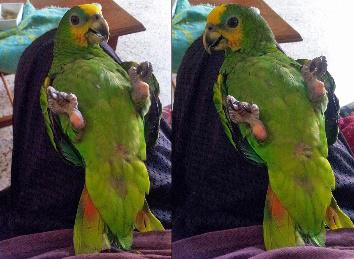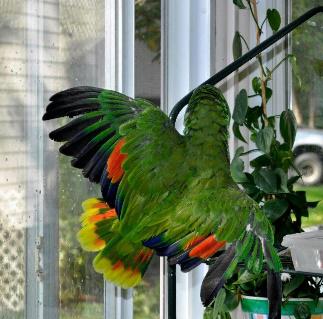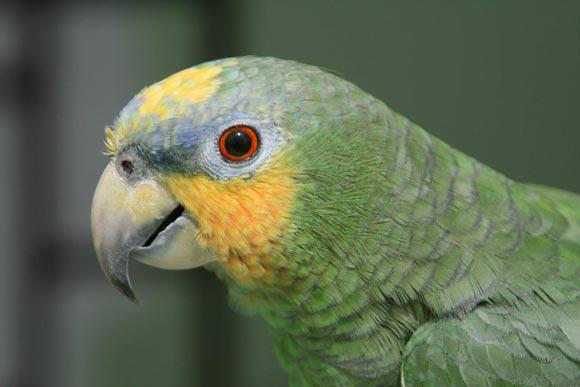Scientific Facts
| Common Name | Orange-winged amazon |
| Scientific Name | Amazona amazonica |
| Lifespan | 50 – 60 Years |
| Size | 12 inches (31cm) |
| Body Mass | 10.4 – 16.5oz. (298 – 470 grams) |
| Habitat | Lowland forests, semi-open country |
| Range | Tropical South America |
Information & Physical Appearance
The Orange-winged Amazon (Amazona amazonica) is a member of the order Psittaciformes, the family Psittacidae, genus Amazona.
Other common names include Orange-winged Parrot and Loro Guaro.
There are two subspecies.
1. A.a amazonica
In both sexes, adults are characterized by yellow coloring on the forecheeks, crown, and forehead. The plumage is mainly green.
The throat displays yellow/green coloration and is tinged with blue. There is a blue-violet band between the eyes, and the lores are also colored in violet/blue.
The amount of yellow and blue coloring on the head varies among individuals.
In the tail, as well as in the wings, there are orange feathers, but these can be only seen when the parrots are in flight. The central tail feathers are green.
The upper mandible is partly dark-grey (near the tip), and partly horn-colored.
The eyes are orange, surrounded by a grey/white eye ring.
2. A.a. tobagensis
The external appearance of male and female tobagensis is identical, just like the case with amazonica adults.
The major difference between the two subspecies is that both tobagensis adults have more extensive orange coloring, which starts from the bases and reaches the secondary feathers (1 – 4 in number).
Also, this subspecies is slightly larger in size than the nominate race.
Juvenile
Juveniles resemble the appearance of mature individuals. However, in juveniles, the eyes are not orange yet but grey/brown instead.
Lifespan

If cared for properly, Amazon parrots are quite long-lived animals, and the Orange-winged Amazon is no exception.
When given proper housing, socialization, balanced nutrition, and exercise, orange-winged parrots can easily live for about 50 – 60 years on average. Not that there are many recorded cases of orange-winged parrots living upwards of 80 years.
Ecosystem & Habitat

Orange-winged amazons are permanent breeding residents in tropical South America.
RANGE
A.a. amazonica is found in the eastern and northern parts of Colombia, northern Venezuela and south in Brazil all the way to Mato Grosso.
More specifically, amazonica’s range includes the Amazonas – Bolivar area, the Amazon River basin, the Guianas, the territory south of Rio Orinoco, western Sao Paulo, eastern Peru, eastern Bolivia and eastern Ecuador.
Although occasionally, this race is also known to occur in coastal Brazil, in particular, the lands from northeastern Sao Paulo to Pernambuco.
A.a. tobagensis is found in Trinidad and Tobago.
HABITAT
Orange-winged parrots utilize a wide array of lowland forests, as well as wooded, semi-open country kinds of habitats.
They can be found in seasonal woodlands, savanna, and the tropical rainforest, as long as there is a water body nearby.
Also, Orange-winged amazons do inhabit cultivated areas characterized by vareza forest, mangroves, trees, and gallery woodlands.
Most commonly, these parrots can be found at elevations of up to 3936ft. (1200 meters), and they thrive below 1968ft. (600 meters) in general.
Food & Diet

The wild diet of orange-winged parrots consists of various seeds, blossoms, and fruit, including but not limited to palm trees’ fruits (Byrsonima, Sloanea and Richeria), as well as the flowers of Erythrina, among other favored food plants.
Sometimes, they also eat cocoa. When food is scarce, Orange-winged amazons may turn to mangoes and oranges available in cultivated areas.
Behavior

Just like other Amazons, orange-winged parrots are known to form flocks in the wild.
Their flocks are unique as they do not constitute of subservient members and a particular leader. Instead, their flocks are more of a commune living in the very same area.
Members of the flocks help each other in finding food. They beware of each other of danger, too.
They roost communally up in the trees, such as palm trees and giant bamboos, among others. Especially large numbers of these parrots can be seen at roost sites during particular hours of the day – at dusk and dawn.
It is this social behavior that is ingrained in orange-winged amazons, and that’s why they require a social environment in order to thrive.
The loud, high-pitched screams these parrots make characterize them as noisy birds. Their calls consist of a variety of sounds – harsh screeches, whistles, bubbles, squawks, screams and thrills.
Reproduction

In the Magdalena Valley, the breeding season begins in December and continues throughout February.
In Trinidad and Tobago, the breeding season starts in January and lasts up until the middle to the end of June.
Orange-winged parrots produce a single clutch per year. The clutch consists of 3-4 eggs.
The eggs are white, ovate, measuring 1.5 x 1.1 inches.
It is in tree cavities where these Amazons nest. The female is in charge of incubating the eggs. Incubation takes about 26 days.
The chicks are ready to leave the nest in around 2 months (60 days) after hatching.
Survival Threats & Conservation

Orange-winged amazons are listed on CITES’ Appendix II.
Furthermore, Amazona amazonica is listed under the Least Concern category on the IUCN Red List of Threatened Species.
The major survival threat is none other but heavy trapping.
Orange-winged parrots are trapped for the wild bird trade, with over 300000 individuals having been recorded victims of illegal international trade ever since 1981.
Also, these parrots are hunted for food on the national and local levels.
Sports hunting for the purpose of specimen collecting is another serious threat.
Nonetheless, habitat loss is a concern.
On the bright side, the wild population of orange-winged amazons is not severely fragmented. These parrots are believed to possibly benefit from land clearance when a mosaic landscape is revealed, and they are highly adaptable.
Even though there is no action recovery plan, conservation sites are identified over the entire range and the species occurs in at least one protected area.
However, the number of mature individuals in the wild remains unknown due to the lack of a systematic monitoring scheme.
Availability – Where to Get an Orange-winged Amazon

Orange-winged amazons are commonly kept in captivity.
You can easily find orange-winged amazons available for sale from avian-specialty stores. Also, you can acquire an orange-winged parrot directly from reputable breeders.
Mind that these amazons used to be more prevalent in aviculture back in time. While their availability varies from one year to another, they are generally slightly fading in popularity in favor of other, flashier Amazons, such as the blue-fronted amazon.
Interesting Facts

1. Being social eater, just like most Amazons, orange-winged parrots will gladly appreciate the opportunity to enjoy shared healthy meals with their beloved people in the family.
2. Because of their similar coloration and size, orange-winged amazons are commonly confused with their close relatives – blue-fronted Amazons (Amazona aestiva).
While the blue-fronted amazon has a blue coloring that reaches from the eye ring to the cere, the orange-winged amazon has a blue face “mask.”
In both species, there is yellow coloring on the face.
Even though the orange-winged parrot’s name suggests that this Amazona species may possess observable orange wings, this is not really the case. Orange-winged parrots only have a visible hint of orange on the shoulders.
However, based on careful inspection, it is easy to spot bright orange feathers on the underside of the wings.
On the other hand, blue-fronted amazons display a dash of red on their shoulders, yet sometimes, there may be more yellowish coloration on the shoulder area.
Both Amazona species have bone-colored and black beaks, but the orange wings’ beak often tends to be paler in color than the blue front’s beak.
3. Orange-winged parrots are becoming feral birds in Florida area, Miami. Also, there are already well-established colonies in England, London.
How to Care for the Orange-winged Amazon
1. Housing & Cage Enrichment
Orange-winged amazons have to be provided with a spacious enclosure, such as a suspended cage or aviary measuring at least 9.8ft. (3 meters) in length.
A variety of bird-safe leather and wood chew toys should be provided. Puzzle toys, ladders, swings and food foraging toys are also strongly recommended to keep the parrot pet mentally stimulated, entertained and happy.
Bathing accessories such as misters and/or suitable water dishes are a must.
2. Diet
Similarly to other Amazons kept as pets, orange-winged parrots require a varied, balanced diet.
Feed your orange-winged amazon every day but do so in moderation.
High-quality pelleted diet and small seed mixtures (low-fat) should make the primary part of the diet (about 70%).
About 30% of a healthy diet should consist of bird-safe, fresh vegetables and fruits, such as pomegranate, oranges, apples, cactus fruits, and pears, to name a few.
Suitable vegetables include green peas, corn, green leaves (lettuce, dandelion, Swiss chard), celery, carrots, cooked pulses, and beans.
Providing complete kibble is a must.
3. Speech and Sounds
As a rule of thumb, the orange-winged amazon does not have the reputation of the noisiest of all Amazons.
However, it is definitely not the quietest parrot either!
Orange wings are more likely to mimic whistles and sounds rather than human speech. Some individuals are capable of learning a few words, though.
4. Personality
Amazons are quite feisty creatures in general.
Orange wings are mellower beasts, as compared with other Amazon parrots.
For potential caregivers who are not willing to deal with the time-and-attention demanding, the huge personality of other Amazons, such as yellow-naped amazons, orange wings can make wonderful pets.
This does not mean that orange-winged amazons are wallflowers. They are renowned for their high spirited, energetic, lively personalities.
To establish a deep, strong bond with your orange-winged feathery fellow, you need to spend a good amount of your time in daily social interactions.
To enjoy an affectionate, mildly-tempered parrot pet, it is best to opt for hand-fed individuals.
5. Common Health Issues
Like most Amazon parrots, orange wings have a tendency to become obese.
They can easily turn into couch potatoes, willingly spending a good part of the day just sitting and eating starchy foods.
But it is your responsibility as an owner NOT to allow this to happen. Pay close attention to the type and amount of food you offer every day.
Also, allow your orange wing plenty of room to exercise outside the cage.
Obesity can lead to fatty tumors. It can also greatly reduce your feathery friend’s lifespan.
Even though orange-winged amazons are very hardy creatures, other common conditions, and diseases that may affect them include
Polyomavirus (may lead to weight loss, lethargy, and anorexia).
Vitamin-A deficiency (can be easily avoided by feeding an adequate diet).
Chlamydiosis (can cause nasal discharge, fluffed feathers, low appetite).
FAQ Section
How Much Do Orange-winged Amazons Cost?
Orange-winged amazons are not among the most expensive Amazon parrots on the market. You can acquire a well-socialized orange-winged parrot at a reasonable price of about $600 – $900 on average.
Are Orange-winged Amazons Good Talkers?
No, orange-winged amazons are not very good talkers, especially when compared to other Amazon parrots. Orange-winged amazons can be very outgoing and mellower than other Amazons, though, and despite being less talkative in general, some individuals may learn a few words with proper training.
Are Orange-winged Amazons Noisy?
Yes, orange-winged amazons can be quite noisy, and especially at dawn and dusk. Even though orange wings are not the quietest of all Amazona species, they are definitely not the noisiest ones either.
What Do Orange-winged Amazons Eat?
In the wild, orange-winged Amazons’ diet includes seeds, flowers, and fruits. In captivity, they will gladly eat daily servings of fresh veggies and fruits, making up for about 30% of the diet, and quality pelleted diet (about 70%).
How Long Do Orange-winged Amazons Live?
Orange-winged amazons usually live for between 50 – 60 years in captivity. However, when given proper care, nutrition, and interaction, they can live up to 80 (or more!) years of age.
How Can You Tell the Difference Between a Male and Female Orange-winged Amazon?
It is quite difficult to tell the difference between a male and a female orange-winged amazon at a glance since both adults are quite similar in external appearance. However, orange wing males tend to have more of a blue on their foreheads, while females have more yellow coloring on their faces.
Are Orange-winged Amazons Endangered?
Orange-winged amazons are not considered severely endangered with extinction but they are categorized on the IUCN Red List of Threatened Species under the category Least Concern. Hunting and trapping of wild orange wings are among the major survival threats.

